Clarifying Autism Spectrum Disorders
Autism Spectrum Disorder (ASD) comprises a broad range of neurodevelopmental differences characterized by difficulties in social communication and repetitive behaviors. Among the spectrum, Asperger Syndrome (AS) was once considered a distinct diagnosis but has since been integrated into ASD under the DSM-5 framework. This article explores the relationships and differences between autism and Asperger’s, delving into their diagnoses, traits, and therapies with a particular focus on applied behavior analysis (ABA) therapy used widely for intervention.
Defining Autism Spectrum Disorder (ASD)
What is Autism Spectrum Disorder (ASD)?
Autism spectrum disorder (ASD) is a group of neurodevelopmental conditions that affect how individuals communicate and interact socially. It encompasses a wide range of related conditions, including what was once separately diagnosed as Asperger syndrome. The spectrum nature of ASD means there is great variability in how symptoms present and how severely they affect daily functioning.
Core Characteristics of ASD
Individuals with ASD typically face challenges in social communication, which can include difficulties understanding social cues, nonverbal communication, and building relationships. Alongside these social challenges, repetitive behaviors and restricted interests are common. Sensory processing differences, such as sensitivity to noises or textures, are also frequently observed. These core features define the diagnosis and help differentiate ASD from other developmental conditions.
Range and Variability Within ASD
ASD includes individuals with a wide range of abilities and needs. Some may have intellectual disabilities, while others, such as those formerly diagnosed with Asperger syndrome, often have average or above-average intelligence with no language delay. The severity of symptoms varies, and some individuals require substantial support, while others, especially those categorized as Level 1 ASD in the DSM-5, require minimal assistance. This spectrum acknowledges the diverse ways in which autism can affect people's lives and highlights the importance of personalized interventions.
What is Asperger Syndrome and How Does it Fit Within ASD?
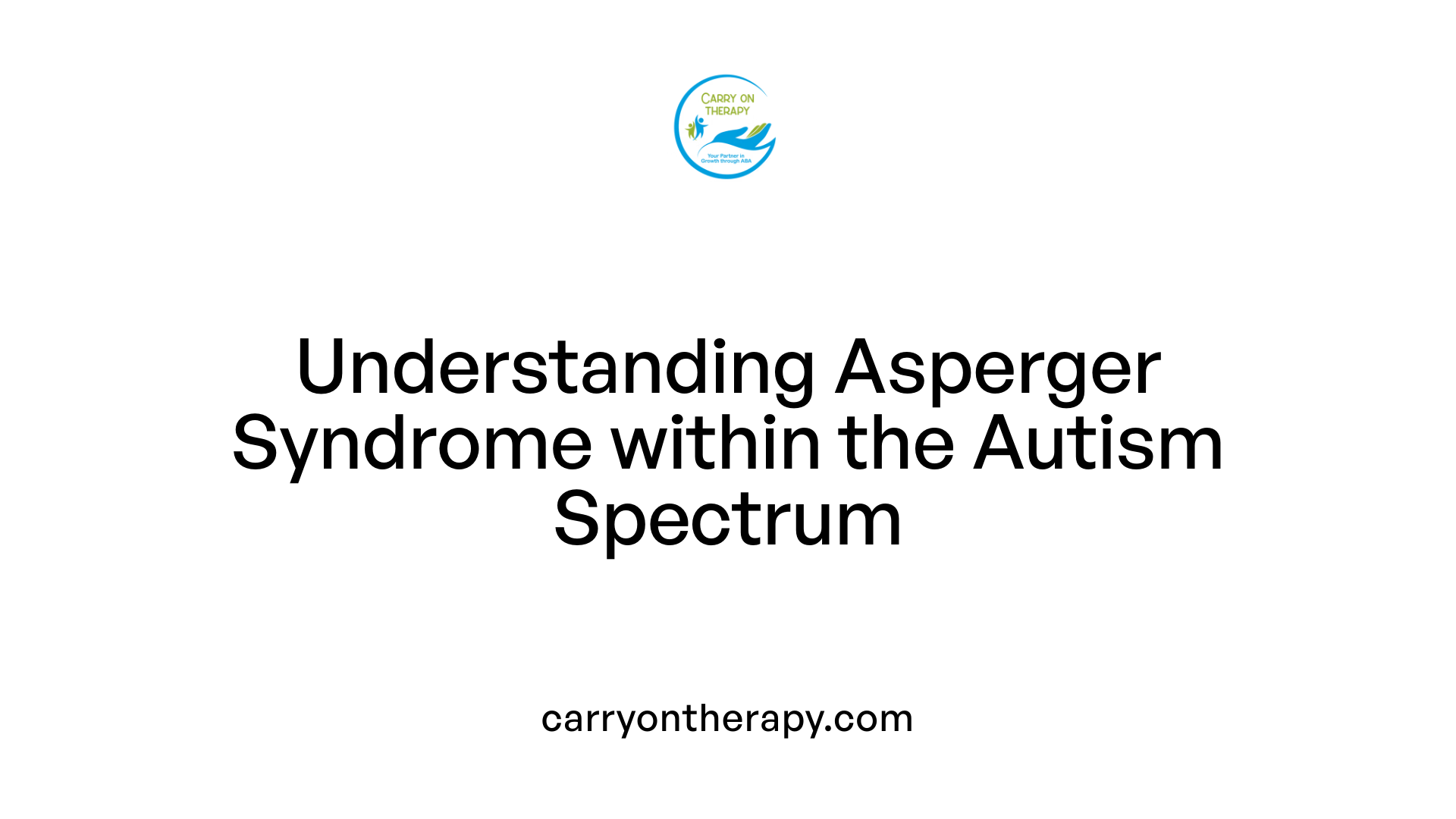
Historical perspective of AS
Asperger syndrome (AS) was first described by Dr. Hans Asperger in 1944, focusing on children with unique social challenges but average to superior intelligence and no significant language delays. For many years, AS was recognized as a distinct condition, officially included in DSM-IV in 1994. This separate classification highlighted its unique features compared to other autism spectrum disorders (ASD).
Incorporation of AS into ASD
With the publication of DSM-5, Asperger syndrome was merged into the broader autism spectrum disorder category. It's now classified as Level 1 ASD, indicating individuals who typically require minimal support. This change reflects a modern understanding of autism as a continuum, where AS represents one part of a spectrum of neurodevelopmental conditions rather than a standalone diagnosis.
Characteristics specific to AS
Individuals with AS face challenges in social communication and interaction, including difficulties with nonverbal cues, empathy, and understanding social relationships. Unlike other autism subtypes, there are generally no delays in language or cognitive development. Many with AS have normal or above-average IQs. They often exhibit restricted and repetitive behaviors, intense interests, and sensitivity to sensory stimuli. Language use is typically fluent but can be literal, making idiomatic expressions and metaphors hard to interpret.
Is Asperger syndrome the same as autism?
Asperger syndrome is a subtype of autism spectrum disorder characterized particularly by difficulties in social communication and interaction but without significant delays in language or cognitive development. While historically recognized as a separate condition, it is now regarded as part of the broader autism spectrum within DSM-5, often referred to as Level 1 ASD, representing individuals who require minimal support.
Core Social and Communication Features in Asperger Syndrome
Social-emotional reciprocity deficits
Individuals with Asperger syndrome (AS) often experience difficulties in social-emotional reciprocity, which means they struggle to engage in the back-and-forth flow of social interactions. This can include challenges in sharing interests, emotions, and responding appropriately in social contexts. For instance, a person with AS may find it hard to initiate or maintain conversations or respond to social cues naturally, making social engagement more demanding.
Nonverbal communication challenges
Nonverbal communication is another area of difficulty for those with AS. They may have trouble interpreting or using facial expressions, eye contact, gestures, and body language effectively. Such challenges can lead to misunderstandings in everyday interactions, as subtle cues that typically guide conversations and express emotions might be missed or misinterpreted.
Understanding social relationships
Children and adults with AS often find it challenging to develop, sustain, and comprehend social relationships. These difficulties stem from impairments in recognizing others’ perspectives, empathy, and theory of mind. As a result, they may appear socially isolated or awkward, struggle with forming friendships, and face anxiety or depression related to social situations. Therapeutic approaches, including social skills training and targeted group interventions, aim to support individuals in building better social understanding and connections.
Language and Cognitive Profiles in Asperger Syndrome Compared to Other ASD
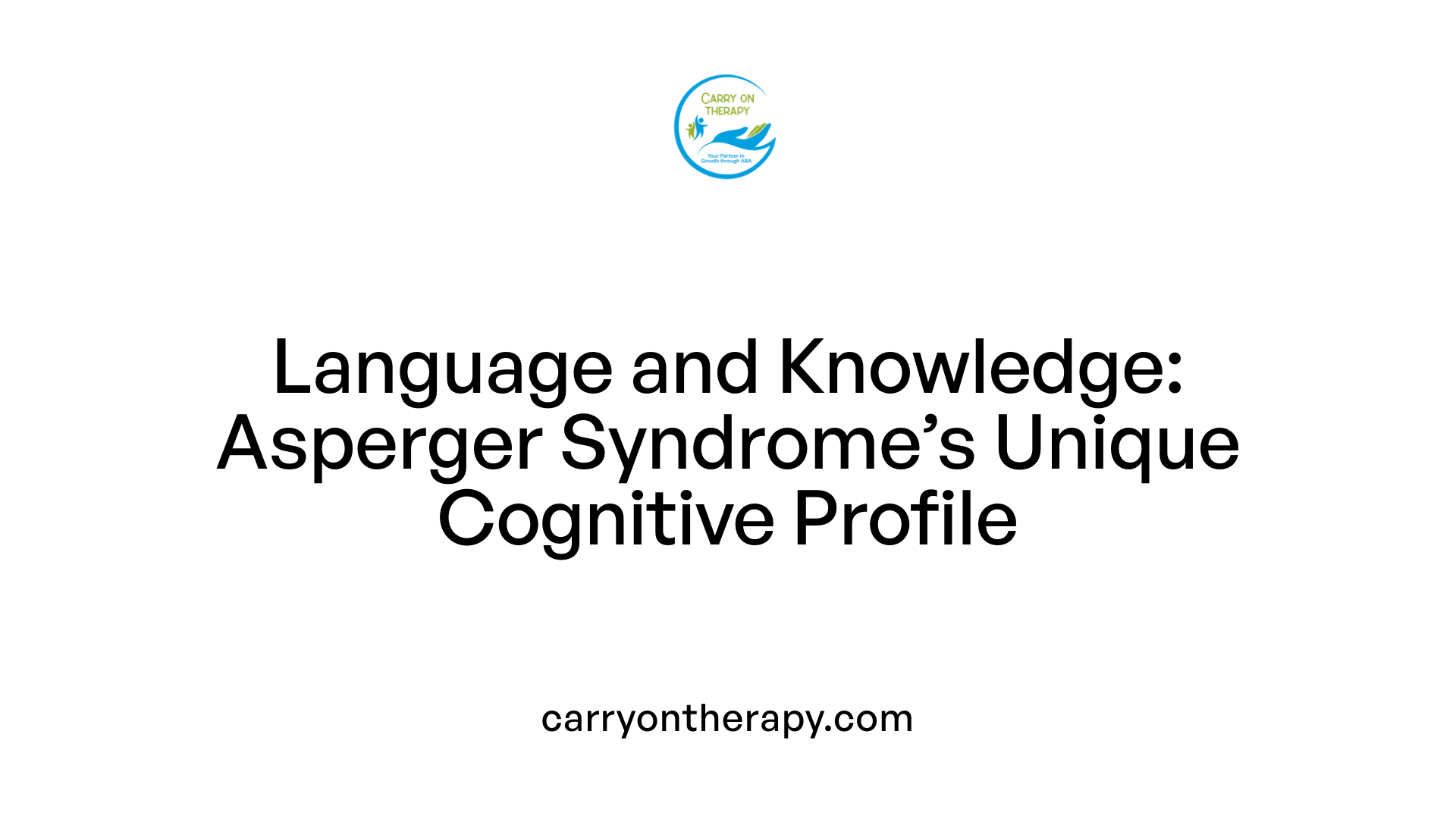
Lack of Language Delay in Asperger Syndrome
One of the defining characteristics that differentiates Asperger syndrome (AS) from other autism spectrum disorders (ASD) is the absence of significant language delay. Individuals with AS typically develop language skills within the expected developmental timeline, which contrasts with many other forms of ASD where language acquisition is notably delayed. This early fluency often allows those with AS to communicate effectively in basic contexts, though challenges remain in more complex aspects of communication.
Typical or Above-Average Intelligence
People diagnosed with Asperger's syndrome generally exhibit normal or above-average intelligence. Unlike other ASD subtypes that might involve cognitive impairments or delays, individuals with AS often demonstrate strengths in specific areas such as memory, attention to detail, and focused interests. Their cognitive ability is a critical factor that often leads to later diagnostic recognition since early developmental milestones, including cognition and language, may appear typical.
Literal Language Use and Challenges with Metaphors
Despite fluent language skills, individuals with Asperger syndrome often show difficulty in understanding non-literal language. Their communication style tends to be very literal, leading to challenges in grasping metaphors, irony, humor, and implied meanings. This literal interpretation can sometimes result in misunderstandings during social interactions and highlights the need for therapists and educators to adapt communication approaches accordingly. Tailored interventions often emphasize clear, direct language to support better comprehension and social engagement.
Understanding these language and cognitive profiles is fundamental for designing personalized support and interventions that cater to the unique needs of people with Asperger syndrome. These distinctions also reinforce why AS is recognized as a distinct subgroup within the broader autism spectrum.
Behavioral Patterns and Sensory Processing in Asperger Syndrome and ASD
What repetitive and restricted behaviors are seen in Asperger Syndrome and ASD?
Individuals with Asperger Syndrome (AS) and broader Autism Spectrum Disorder (ASD) typically display repetitive and restricted behaviors. These can include intense, focused interests on specific topics or activities and adherence to routines or rituals. Such behaviors often help create predictability and comfort but may interfere with daily functioning if they become too rigid.
How do sensory sensitivities manifest in AS and ASD?
Sensory processing differences are common in both AS and ASD. People might experience hypersensitivity, becoming easily overwhelmed by stimuli like loud noises, bright lights, or certain textures. Conversely, some individuals exhibit hyposensitivity, showing decreased responsiveness to sensory inputs. These sensory profiles affect how they interact with environments and can influence emotional regulation.
What motor issues are associated with Asperger Syndrome and how are they addressed?
Motor clumsiness is frequently observed in those with AS, manifesting as difficulties with coordination or fine motor skills. Occupational therapy and engaging in physical activities are effective approaches to improving motor abilities and sensory integration. Structured therapeutic environments that accommodate sensory needs also aid in creating a sense of safety and support progress.
These behavioral and sensory features illustrate the complexity of AS and ASD, highlighting why customized interventions are essential. Therapies targeting these areas can significantly enhance quality of life by addressing individual challenges in social and sensory domains.
Diagnostic Assessment Processes for Autism and Asperger’s
What screening tools are used for initial detection?
Early identification of autism spectrum disorder (ASD) and Asperger's syndrome (AS) often begins with screening tools designed to flag potential concerns in social and communicative behaviors. Common screening methods include the Modified Checklist for Autism in Toddlers (M-CHAT) and the Social Communication Questionnaire (SCQ). These tools help detect early signs of ASD in young children, facilitating prompt referral for more comprehensive evaluation.
Which formal diagnostic assessments are commonly employed?
To confirm an ASD or AS diagnosis, clinicians use specialized assessments such as the Autism Diagnostic Observation Schedule, Second Edition (ADOS-2) and the Autism Diagnostic Interview-Revised (ADI-R). ADOS-2 involves direct observation and interaction to evaluate social communication and behavior patterns, while ADI-R relies on detailed caregiver interviews about developmental history and current behaviors. These assessments provide structured and standardized insights into the individual's characteristics across the autism spectrum.
When is diagnosis usually made for ASD and AS?
The timing of diagnosis varies notably between ASD and AS. Autism symptoms can often be identified between 1 to 3 years old due to more readily observable developmental delays. In contrast, a diagnosis of Asperger's syndrome is frequently delayed until around age 11 or later, especially for those with higher cognitive abilities and no significant language delays. This delay happens because individuals with AS may develop coping mechanisms that mask social difficulties in early childhood.
Understanding the combination of screening tools and diagnostic assessments is essential for accurate and timely identification of individuals on the autism spectrum, including those with Asperger's syndrome. Early and precise diagnosis supports access to appropriate interventions and better long-term outcomes.
Why is Asperger Syndrome Often Diagnosed Later Than Other Forms of Autism?
Delayed Recognition in Higher-Functioning Individuals
Asperger Syndrome (AS) is characterized by average or above-average intelligence and typical language development, distinguishing it from other forms of Autism Spectrum Disorder (ASD) that may present with more obvious delays. These higher-functioning individuals often possess subtle social difficulties that can be overlooked or misunderstood. As a result, symptoms may not become apparent or disruptive enough to prompt evaluation during early childhood.
Typical Age Ranges for Diagnosing AS
While ASD symptoms can be recognized as early as ages 1 to 3, diagnoses of AS commonly occur later, frequently between ages 4 and 11, and sometimes even into adolescence or adulthood. This delay is attributable to the less overt nature of social communication challenges and repetitive behaviors in AS compared to other ASD subtypes.
Impact of Subtle Symptoms and Coping Mechanisms
Individuals with AS may develop personal strategies to navigate social settings that mask their difficulties. These coping mechanisms can create an impression of neurotypical behavior in certain contexts, further postponing recognition and diagnosis. The subtlety of symptoms—such as challenges with nonverbal cues or theory of mind—can be mistaken for personality quirks rather than indicators of a developmental condition, complicating timely identification and intervention.
The Importance of Early Identification and Intervention in ASD and AS
Benefits of early diagnosis
Early diagnosis of Autism Spectrum Disorder (ASD) and Asperger Syndrome (AS) offers significant advantages. Identifying symptoms as early as ages 1 to 3 allows families and professionals to implement supportive therapies sooner, maximizing developmental gains. Although AS diagnoses often occur later, frequently around age 11 or beyond due to subtler social difficulties and average or above-average intelligence, earlier recognition can still facilitate more timely support.
Role of intervention timing
The timing of intervention critically affects outcomes. When applied behavioral analysis (ABA), speech therapy, and developmental interventions begin early, children with ASD and AS generally show improved social communication and reduced repetitive behaviors. Structured environments and tailored therapies accommodate sensory sensitivities and motor challenges common in AS, promoting engagement and learning. Delayed diagnosis, particularly common in AS, can postpone these benefits, underlining the need to enhance awareness and screening efforts.
Long-term outcomes related to early therapy
Longitudinal studies indicate that children who receive early, evidence-based therapies often have better social-emotional reciprocity, enhanced language use, and greater independence. Adults with AS who benefited from early intervention tend to manage social and occupational challenges more effectively. Early therapy also lowers risks for anxiety and depression by addressing emotional and social difficulties proactively. Overall, early identification coupled with appropriate intervention fosters improved quality of life and functional outcomes for individuals across the autism spectrum.
Applied Behavior Analysis (ABA) Therapy: An Overview
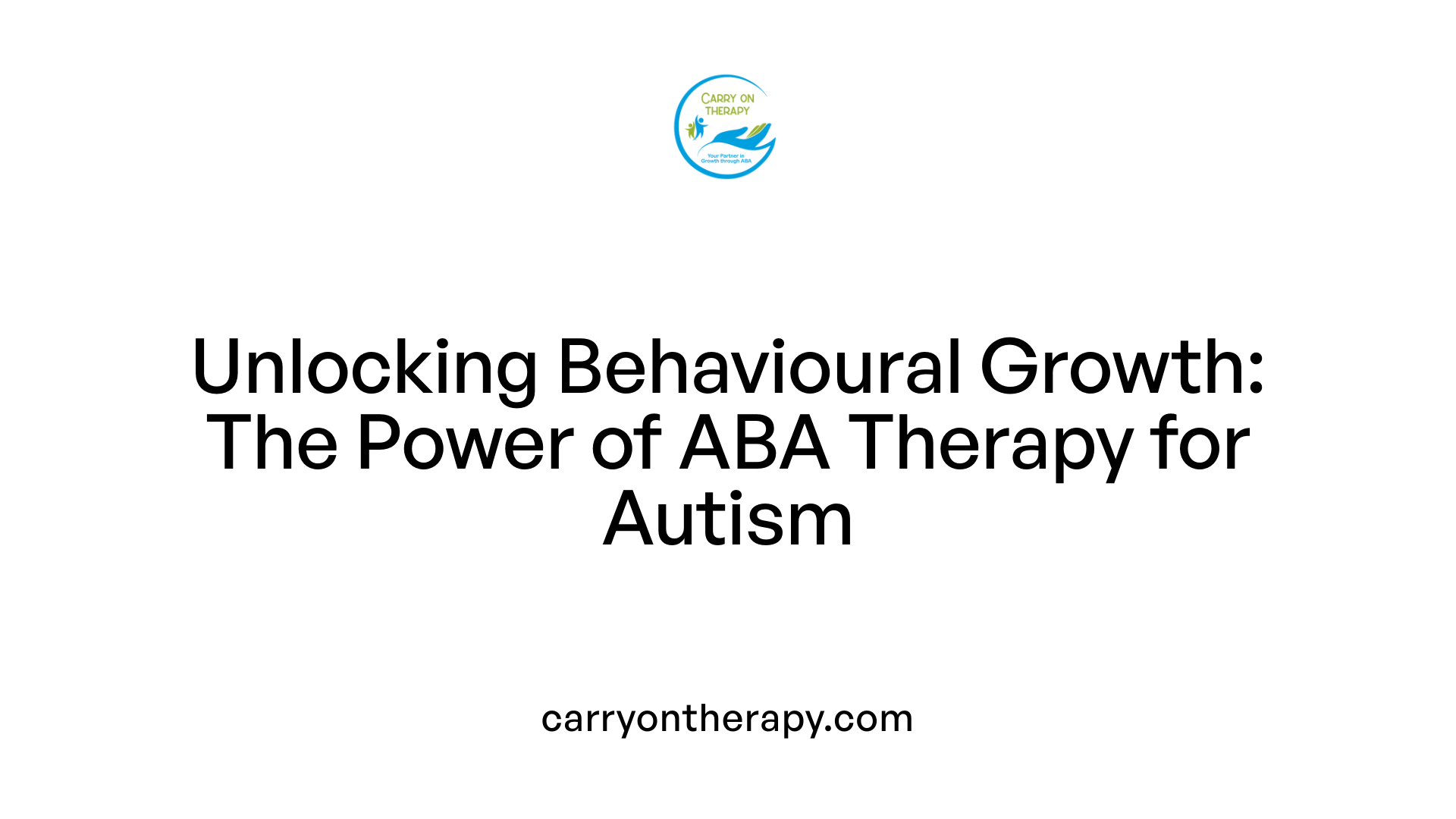
What is applied behavior analysis (ABA) therapy and how is it used to treat autism?
Applied Behavior Analysis (ABA) therapy is a science-based method that leverages the principles of learning and behavior to support individuals on the autism spectrum. Central to ABA is the use of positive reinforcement to encourage beneficial behaviors and reduce those that are harmful or unhelpful.
ABA therapy begins with careful behavior assessment, often using the ABC model — antecedents (what happens before a behavior), behavior itself, and consequences (what happens after). This evaluation guides the development of individualized treatment plans overseen by board-certified behavior analysts (BCBAs).
The goals of ABA for individuals with autism include enhancing language, social communication, and adaptive skills such as daily living activities. Therapeutic methods like Discrete Trial Training (DTT) focus on breaking skills into smaller, teachable units, while Pivotal Response Treatment (PRT) targets core areas like motivation and self-management to produce broader improvements.
ABA therapy is versatile and delivered in various environments, including homes, schools, and community settings. Early and consistent intervention — often spanning several hours per week — has been shown to produce valuable developmental gains. This evidence-supported approach is recognized as one of the most effective behavioral therapies for autism spectrum disorders, including Asperger's syndrome.
By tailoring interventions to each individual's unique needs, ABA therapy strives to improve quality of life and promote greater independence and social competence.
Who Provides ABA Therapy for Individuals with Autism?
Who typically provides ABA therapy for individuals with autism?
ABA therapy is delivered by a dedicated team of highly trained professionals. This team typically includes board-certified behavior analysts (BCBAs), Registered Behavior Technicians (RBTs), and behavioral therapists. Each plays a distinct role:
- BCBAs develop individualized behavior intervention plans based on thorough functional behavior analyses.
- RBTs implement these plans directly during therapy sessions under the supervision of BCBAs.
- Behavioral therapists may also contribute to therapy by applying behavioral techniques and supporting skill development.
In what settings is ABA therapy provided?
ABA therapy can be administered in various environments, ensuring flexibility and relevance to the child's everyday life. Common settings include:
- Clinics specialized in developmental and behavioral interventions.
- The child’s home, offering a natural setting for learning.
- Schools, integrating therapy with educational activities.
- Community centers, promoting social engagement and generalization of skills.
How important is parent training and involvement?
Parents and caregivers are essential partners in ABA therapy. Effective programs provide parent training to empower families with strategies to reinforce skills at home and manage challenging behaviors. This collaboration helps maintain consistency and promotes progress outside formal sessions. The involvement of parents enhances generalization of skills, making therapy more impactful over time.
Overall, ABA therapy providers have extensive knowledge in behavioral analysis and work closely as a team to customize interventions. This team-oriented and flexible approach ensures that therapy meets the unique developmental goals of each individual with autism.
Key Components and Techniques of ABA Therapy
What are the key components and techniques used in ABA therapy?
Applied Behavior Analysis (ABA) therapy is a structured approach designed to improve social, communication, and daily living skills, especially for individuals on the autism spectrum, including those with Asperger’s syndrome. Central to ABA therapy are detailed behavioral assessments and the creation of individualized treatment plans tailored to the unique needs of each person.
ABA therapists meticulously collect data to track progress, ensuring interventions remain effective and adaptive. At the heart of ABA is the use of positive reinforcement, where desirable behaviors are immediately rewarded to encourage their recurrence. This technique often works in tandem with prompting, where cues or assistance are gradually given and then faded to help individuals independently achieve targeted behaviors.
Behavior chaining is another important technique in ABA. It involves breaking down complex tasks into smaller, manageable steps that are taught sequentially, allowing learners to master each part and then connect them smoothly. Modeling, including visual aids and video modeling, provides clear demonstrations of expected behaviors and skills, making abstract concepts more concrete and easier to grasp.
A fundamental framework guiding ABA interventions is the Antecedent-Behavior-Consequence (ABC) model. This approach helps therapists identify what triggers a behavior (Antecedent), the observable behavior itself, and the result or response (Consequence). Understanding this sequence enables precise adjustments to reduce challenging behaviors and reinforce positive ones.
Other techniques such as extinction (discontinuing reinforcement of unwanted behavior), redirection, and script fading are employed to support behavior modification and promote independence.
All these methods are developed and implemented by certified behavior analysts (BCBAs), ensuring scientific rigor and personalized care. ABA is adaptable across contexts—whether at home, school, or in the community—providing a comprehensive, evidence-based way to enhance functioning in individuals with ASD and Asperger’s.
Below is a summary table highlighting these components and techniques:
| Component/Technique | Description | Purpose/Benefit |
|---|---|---|
| Behavioral Assessments | Evaluation tools to identify behavioral challenges | Guides personalized treatment plans |
| Individualized Treatment | Customized programs based on patient needs | Maximizes therapy effectiveness |
| Positive Reinforcement | Rewarding desired behaviors | Increases occurrence of good behaviors |
| Prompting & Fading | Assisting and gradually withdrawing help | Builds independence |
| Behavior Chaining | Teaching complex tasks in small, connected steps | Facilitates learning of multi-step behaviors |
| Modeling | Demonstrations using live or video examples | Improves comprehension and imitation |
| ABC Model | Analyzing antecedent, behavior, and consequence | Identifies triggers and outcomes to modify behavior |
| Extinction | Withholding reinforcement of undesired behavior | Reduces unwanted behaviors |
| Redirection | Shifting attention from undesired to desired behavior | Helps manage challenging behaviors |
| Script Fading | Gradual reduction of scripted prompts | Encourages natural communication |
Scientific Evidence Supporting ABA Therapy for Autism Spectrum Disorders
What evidence supports the effectiveness of ABA therapy for individuals with autism?
ABA therapy is strongly supported by numerous scientific studies demonstrating its positive impact on individuals with autism spectrum disorders (ASDs), including Asperger syndrome (AS). These studies show that ABA interventions lead to significant improvements in social skills, communication, and adaptive behaviors. For example, research involving structured and individualized ABA programs with children on the spectrum has demonstrated meaningful gains in language development, emotional regulation, and independence.
ABA uses evidence-based techniques such as positive reinforcement, functional behavior analysis, and tailored behavioral plans to address specific challenges faced by individuals with ASD and AS. These methods help reduce disruptive behaviors and increase desirable social and communication skills.
Recognitions by major health organizations highlight ABA as a gold-standard treatment. Both the US Surgeon General and the American Psychological Association endorse ABA for its proven effectiveness when delivered in an intensive, consistent manner. Early intervention and parental involvement in ABA therapy further enhance outcomes, promoting the generalization of skills into daily life.
Individualized and intensive intervention is essential because autism spectrum conditions manifest uniquely in each person. ABA practitioners develop behavior intervention plans tailored to the individual's strengths, needs, and environment, ensuring the therapy is relevant and impactful. This personalized approach is particularly important for individuals with AS, who often exhibit normal or above-average intelligence but require specific support to navigate social communication and behavioral challenges.
In summary, ABA therapy's effectiveness for autism spectrum disorders is validated by robust research evidence, expert endorsements, and clinical practice emphasizing individualized, intensive approaches for meaningful behavioral improvements.
Engaging Families and Caregivers in ABA Therapy
How can families and caregivers get involved in ABA therapy?
Families and caregivers play a vital role in the success of Applied Behavior Analysis (ABA) therapy by actively participating in their child’s intervention process. One key way they can contribute is by implementing reinforcement strategies and skill-building activities at home. This practice helps generalize the skills learned during therapy sessions across different environments, leading to more consistent progress.
Training and education for caregivers
To support their involvement, caregivers are often provided with training sessions that cover ABA principles and practical techniques. These sessions empower them with the knowledge and confidence necessary to reinforce treatment goals effectively. Understanding how data collection and progress monitoring work enables them to collaborate with therapists in fine-tuning interventions to suit their child’s unique needs.
Collaboration between families and therapists
The partnership between families and therapists is fundamental in tailoring interventions and ensuring continuity. Caregivers bring insights about their child's behavior in natural settings, which therapists incorporate into individualized treatment plans. Maintaining open communication creates a balanced relationship, where caregivers are deeply engaged without feeling overwhelmed, fostering a supportive environment that benefits the child’s development.
By ensuring that parents and caregivers are equipped, involved, and seen as active team members, ABA therapy becomes a more holistic approach. This collaboration enhances the effectiveness of behavioral interventions for children with autism spectrum disorders, including those with Asperger’s syndrome, ultimately paving the way for better developmental outcomes.
Common Criticisms and Challenges of ABA Therapy
What are common challenges or criticisms of ABA therapy in autism treatment?
Applied Behavioral Analysis (ABA) therapy, widely used for autism spectrum disorders including Asperger’s syndrome, is not without its controversies. Many common criticisms focus on its structured, compliance-driven nature. ABA often emphasizes behavior modification through reinforcement, which some argue can prioritize obedience over understanding the individual's preferences and dignity.
Critics highlight that some ABA practices may discourage natural autistic behaviors such as stimming (repetitive movements) and atypical eye contact. These behaviors, rather than being harmful, often serve as coping or self-regulating mechanisms. Suppressing them might inadvertently cause emotional distress.
Another significant concern is the risk of trauma or emotional exhaustion. Intense and early ABA interventions have, in some cases, led to feelings of anxiety, fatigue, and even symptoms resembling post-traumatic stress disorder (PTSD) in children undergoing therapy. This raises questions about the therapy's emotional impact.
Moreover, the emphasis on reducing "undesirable" behaviors can lead to masking—where autistic individuals hide their natural responses to fit neurotypical social norms. This can severely affect mental health and the development of a healthy self-identity.
Despite these criticisms, many professionals stress that ABA’s effectiveness depends heavily on its implementation. Person-centered, flexible approaches that honor each individual's unique needs and communication styles are advocated to minimize potential harm while supporting development.
| Criticism Aspect | Description | Impact on Individuals |
|---|---|---|
| Structure and Compliance Focus | Highly directive methods emphasize obedience and control over preference and autonomy. | May reduce personal agency and comfort |
| Suppression of Natural Behaviors | Interventions may discourage stimming and eye contact, which are coping mechanisms for autistic people. | Can cause distress and hinder self-regulation |
| Emotional Distress and Trauma | Intensive therapy might lead to emotional exhaustion or PTSD-like symptoms in some children. | Increased anxiety and emotional harm |
| Masking and Identity Impact | Reduction of natural behaviors risks hiding authentic self-expression, leading to mental health issues. | Higher risk of depression, anxiety |
Using Restricted Interests in Asperger Syndrome Therapy
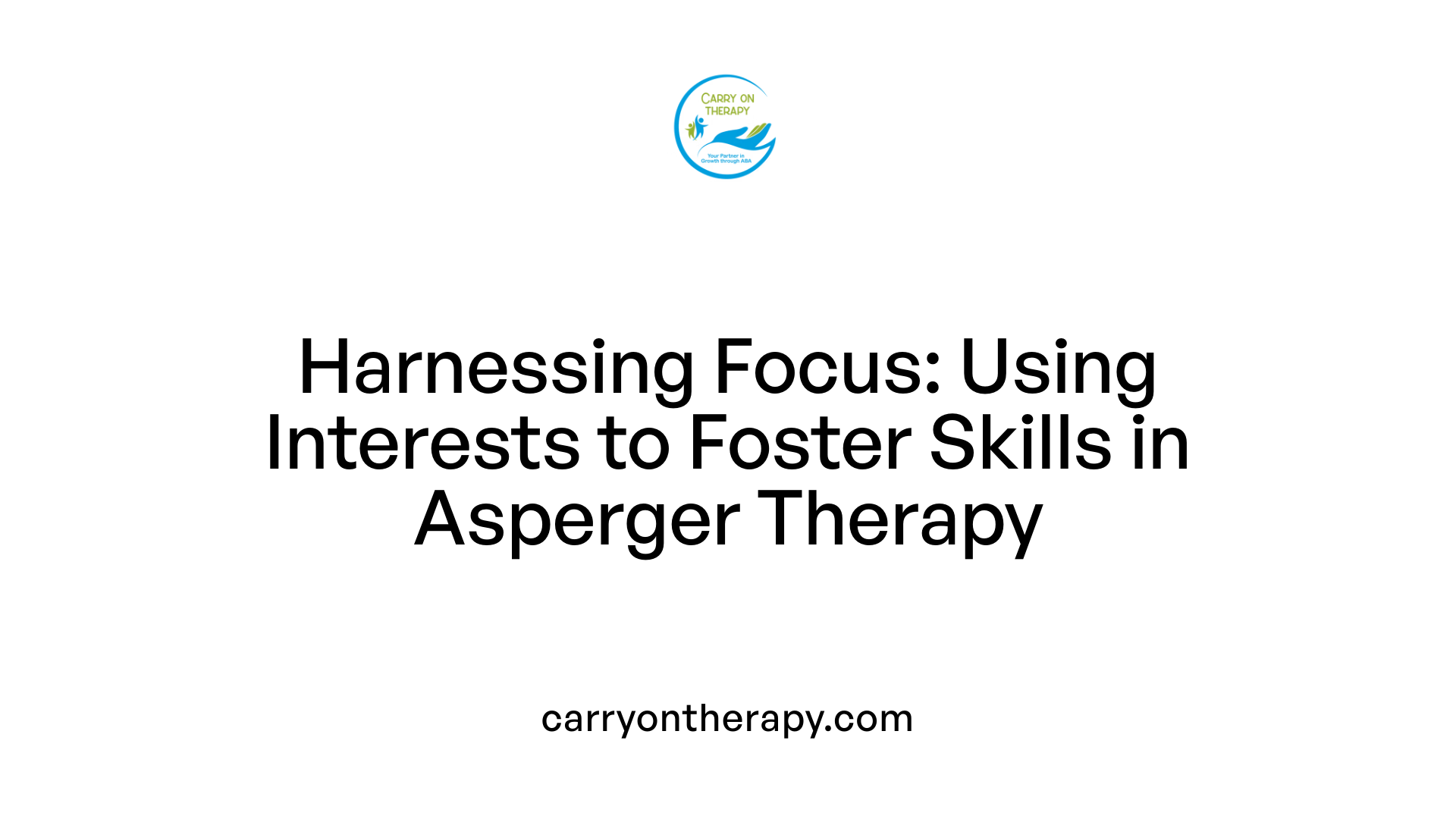
Leveraging Intense Interests for Therapy Engagement
People with Asperger syndrome (AS) often have highly focused and intense interests in specific topics or activities. Therapists can use these restricted interests as powerful tools to engage individuals during therapy sessions. By incorporating subjects that naturally captivate the person with AS, therapists create a motivational environment that encourages participation and communication.
Building Rapport and Motivation
Restricted interests help build rapport between the therapist and the individual. When therapy involves topics the person is passionate about, it fosters trust and enthusiasm, making it easier to introduce new concepts and skills. This approach not only increases motivation but also reduces anxiety often associated with social interactions or unfamiliar activities.
Incorporating Interests into Social Skills Training
Integrating these interests into social skills interventions, such as group therapy or video modeling, can make social learning more relatable and effective. For example, using a favored theme in role-playing scenarios or group activities helps individuals practice social communication in meaningful contexts. This method enhances understanding of social cues and encourages interaction with peers who share similar interests.
By thoughtfully harnessing restricted interests, therapists create personalized strategies that support social connection and skill development in individuals with AS, fostering better outcomes in therapy.
Social Skills Interventions Beyond ABA for Asperger Syndrome
Group interventions and peer activities
Group interventions provide social settings where individuals with Asperger syndrome can practice interaction skills in a supportive environment. These sessions often include structured peer activities that encourage cooperation, sharing, and communication, helping participants improve their social-emotional reciprocity and understanding of nonverbal cues.
Video modeling and LEGO therapy
Video modeling uses recorded demonstrations of social scenarios as a learning tool, allowing individuals with Asperger’s to observe and imitate appropriate social behaviors at their own pace. LEGO therapy, a hands-on group activity, engages participants in collaborative construction tasks, promoting communication, joint attention, and teamwork while leveraging their often strong and focused interests in specific topics.
Effectiveness and applications
Research indicates these therapies can positively influence social skills by building confidence and reducing social isolation. Utilizing activities aligned with an individual’s interests enhances motivation and engagement. Such interventions complement approaches like applied behavioral analysis (ABA) by targeting specific social communication challenges common in Asperger syndrome, including difficulties with empathy, theory of mind, and nonverbal communication. Overall, these behavioral therapies are effective components in comprehensive treatment plans, supporting individuals with Asperger’s in developing meaningful social connections.
Emotional and Mental Health Considerations in Asperger Syndrome
Challenges in emotional processing
Individuals with Asperger Syndrome (AS) often face difficulties in processing emotions, which is linked to differences in brain regions such as the amygdala and hippocampus. These neurological differences can affect how they perceive and respond to emotional stimuli, making it challenging to recognize and express feelings in typical ways.
Higher risks of anxiety and depression
Due to these emotional processing challenges and social difficulties, people with AS have a higher risk of developing mood disorders, including anxiety and depression. Social isolation, misunderstandings, and sensory sensitivities can exacerbate these mental health challenges, emphasizing the need for targeted support.
CBT and tailored emotional therapies
Cognitive-behavioral therapy (CBT) has proven effective for managing emotional difficulties in individuals with Asperger Syndrome. Therapy tailored to the client’s unique needs—such as using direct communication, avoiding metaphors, and providing structured environments—helps improve emotional regulation, reduce anxiety, and address social problems. These approaches support better mental health outcomes by considering the specific ways individuals with AS understand and interact with the world around them.
Sensory Processing and Therapy Adaptations for Asperger Syndrome
Sensory Sensitivity and Hyposensitivity
Individuals with Asperger syndrome (AS) often experience unique sensory processing issues, which can manifest as heightened sensitivity or, conversely, reduced sensitivity to sensory stimuli. This variability means that some may find certain sounds, lights, or textures overwhelming, leading to sensory overload. Others might seek increased sensory input to feel engaged or balanced, a condition known as hyposensitivity.
Creating Predictable and Structured Environments
Given these sensory challenges, therapies for people with AS benefit greatly from environments that are predictable and structured. Such settings help reduce anxiety and sensory overload by limiting unexpected stimuli. When therapy spaces provide consistency and clear routines, individuals with AS feel more secure and able to focus on learning and social interaction.
Occupational Therapy Benefits
Occupational therapy (OT) plays an important role in addressing sensory processing difficulties. OT can help individuals manage their sensory sensitivities and motor clumsiness through tailored activities that improve sensory integration and motor skills. Additionally, physical activity incorporated into therapy supports overall wellbeing and assists with coordination challenges common in Asperger syndrome.
By acknowledging sensory processing differences and adapting therapy methods accordingly, interventions become more effective, fostering greater engagement and progress for those with Asperger syndrome.
Understanding Asperger Syndrome as Neurodiversity
The spectrum concept and individuality
Asperger Syndrome (AS) is now understood as part of the broader Autism Spectrum Disorder (ASD), reflecting the complex continuum of neurodevelopmental differences. This spectrum concept emphasizes that each individual with AS presents a unique combination of traits and abilities — from average or above-average intelligence to distinct challenges in social communication and sensory processing. Recognizing this diversity helps avoid oversimplified labels and supports a more personalized approach to understanding autistic experiences.
Respecting autistic identity
Embracing AS as a form of neurodiversity means valuing the identity and lived experiences of those on the spectrum. Many individuals with AS develop coping mechanisms that allow them to navigate social situations and may be perceived as neurotypical in some contexts. Honoring their identity involves acknowledging their strengths, such as focused interests and unique perspectives, while also understanding their challenges without stigmatization. This respect fosters self-acceptance and empowerment within the autism community.
Balancing support with self-expression
Effective support for individuals with AS involves a balance between providing necessary assistance and encouraging authentic self-expression. Behavioral therapies like applied behavior analysis (ABA), social skills training, and cognitive-behavioral therapy (CBT) are valuable when tailored to individual needs and communicated clearly. Additionally, structured environments that consider sensory sensitivities and emotional processing differences create safer spaces. These approaches help individuals with AS thrive socially and emotionally without suppressing their identities or self-expression.
Distinct Neurobiological Findings Supporting Asperger Syndrome’s Place Within ASD
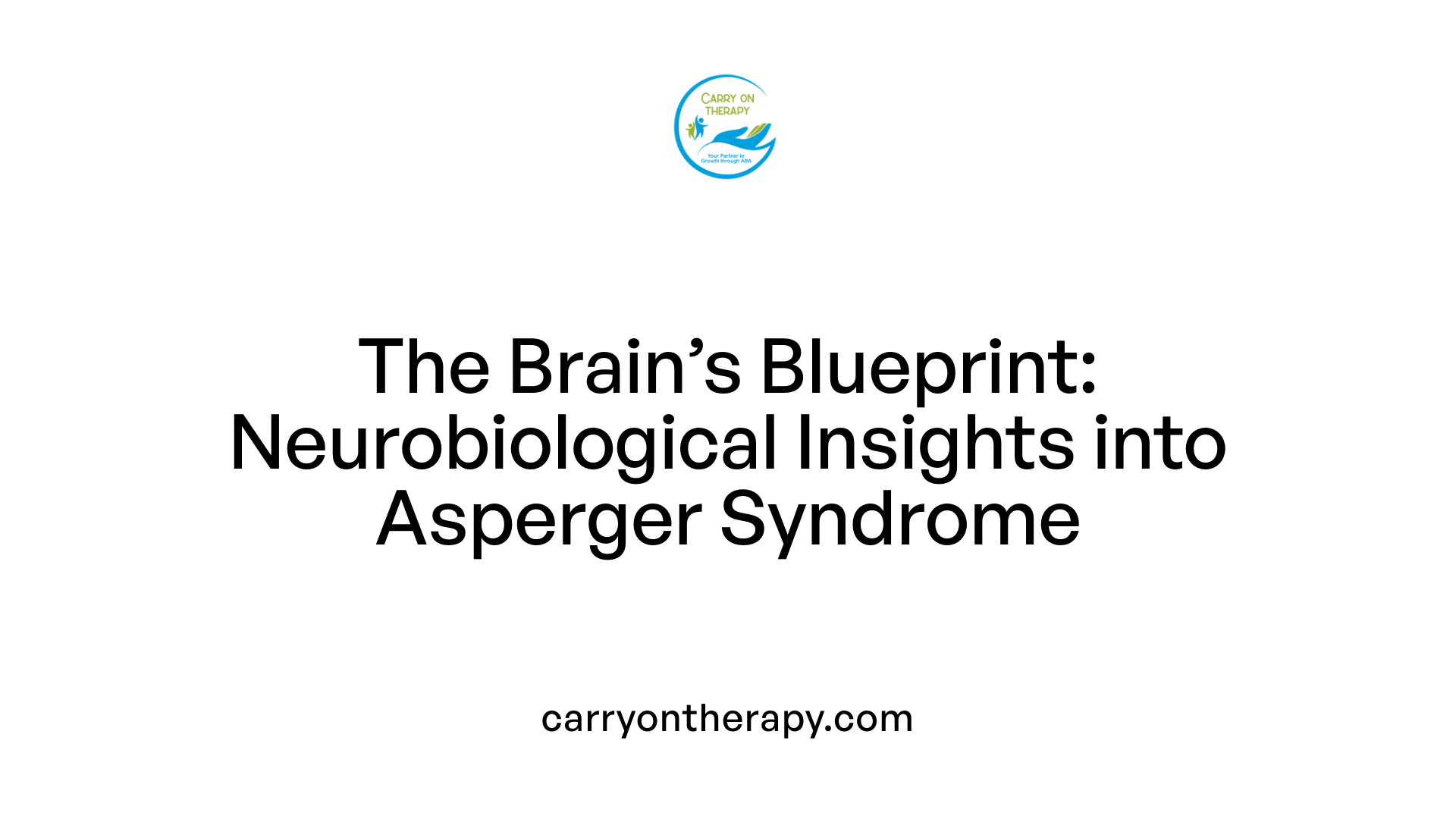
Brain Differences in AS
Neurobiological studies have identified specific brain differences in individuals with Asperger syndrome (AS) compared to other autism spectrum disorder (ASD) subtypes and neurotypical individuals. These differences often include variations in grey matter volume in particular brain regions.
Neural Correlates of Social and Emotional Processing
Research highlights altered functioning in brain areas responsible for social-emotional reciprocity, such as the amygdala and hippocampus. These differences correlate with difficulties that individuals with AS face in emotional processing, empathy, and theory of mind, which influence social interactions and contribute to challenges like anxiety and depression.
Scientific Support for Subgroup Classification
These neurobiological findings reinforce the notion of AS as a distinct subgroup within the broader ASD classification. By demonstrating unique neural patterns related to social communication and emotional regulation, scientific evidence supports differentiating AS within the spectrum, even though it is grouped under Level 1 ASD in the DSM-5. This insight aids in tailoring interventions according to the neurobiological profile of individuals with AS for more effective therapy and support.
Differentiating Asperger Syndrome from Other Conditions like Schizophrenia
Key differences in onset and symptoms
Asperger Syndrome (AS), a subtype within Autism Spectrum Disorder (ASD), typically manifests in childhood, with social communication difficulties and repetitive behaviors apparent early on. In contrast, schizophrenia often has a later onset, usually during adolescence or early adulthood, and is characterized by psychosis, including hallucinations and delusions, which are absent in AS.
Behavioral pattern distinctions
Individuals with AS exhibit challenges in social-emotional reciprocity, nonverbal communication, and maintaining relationships, alongside intense interests and specific sensory behaviors. Schizophrenia exhibits disorganized thinking, hallucinations, and impaired reality testing, which are not features of AS. Furthermore, people with AS may develop coping mechanisms to appear neurotypical, whereas schizophrenia involves more profound disruptions in thought and perception.
Avoiding misdiagnosis
Because some social withdrawal and odd behaviors occur in both conditions, careful clinical evaluation is necessary. Screening tools and diagnostic assessments focusing on developmental history, presence or absence of language delays, cognitive profile, and psychotic symptoms aid in accurate diagnosis. Recognizing that AS symptoms appear early and lack psychosis is crucial to avoiding mislabeling AS as schizophrenia, ensuring appropriate interventions and support are provided.
Prognosis and Adult Outcomes for Individuals with Asperger Syndrome
What Social and Occupational Challenges Do Adults with Asperger Syndrome Face?
Adults with Asperger syndrome (AS) often encounter social challenges rooted in difficulties understanding social cues, nonverbal communication, and emotional reciprocity. These challenges can lead to social isolation, anxiety, and sometimes depression. In occupational settings, they might struggle with interpreting unwritten workplace norms, adapting to social expectations, and managing sensory sensitivities, which could affect job performance and peer relationships.
How Do Coping Strategies Influence Independence?
Many individuals with AS develop personalized coping strategies over time, such as relying on routines or using interests as a social bridge. These mechanisms can help them navigate social environments and be perceived as neurotypical in some contexts. Such self-developed skills often promote greater independence in daily living and work, allowing many adults to manage social and occupational demands with increasing confidence.
Why Is Ongoing Support Important?
Despite many adults with Asperger syndrome achieving functional independence, ongoing support remains crucial. Early intervention combined with continuous therapies—such as social skills training, cognitive-behavioral therapy, and occupational therapy—can significantly improve outcomes. Supportive environments that provide structure and predictability help minimize sensory overload and reduce anxiety. Family, community programs, and professional services all contribute to sustained progress and better quality of life for individuals with AS.
The Legacy of Dr. Hans Asperger and Evolution of Asperger Syndrome Concept
Historical background
Asperger syndrome (AS) was originally described by Dr. Hans Asperger in 1944 through his studies of developmental disorders in children. Asperger identified a distinct condition characterized by social communication challenges, repetitive behaviors, and average or superior intelligence without significant language delay. His pioneering work laid the foundation for understanding this unique neurodevelopmental pattern.
Developmental disorder studies
Dr. Asperger's research emphasized the particular social and behavioral traits observed in the children he studied. These included difficulties with social reciprocity, understanding nonverbal cues, and forming relationships. Over time, these observations helped define a clinical profile that distinguished Asperger syndrome from other developmental disorders prevalent at the time.
Transition to modern diagnostic frameworks
As clinical research progressed, Asperger syndrome was officially included in the DSM-IV in 1994 as a distinct diagnosis. However, reflecting an evolving understanding of autism-related conditions, the DSM-5 integrated Asperger syndrome under the broader category of autism spectrum disorder (ASD) in 2013. This shift highlights the current perspective of ASD as a spectrum, with AS representing a less severe form often requiring minimal support, now known as Level 1 ASD.
Language and Communication Nuances in Asperger Syndrome Therapy
Fluent Yet Literal Language Use
Individuals with Asperger syndrome (AS) typically demonstrate fluent language skills without delays in development. However, their use of language tends to be very literal. Unlike neurotypical peers, they often interpret words and sentences in a straightforward, concrete manner.
Difficulty with Metaphors and Implied Meanings
This literalness means that people with AS frequently struggle to understand metaphors, irony, sarcasm, and implied meanings. For example, figurative speech such as "it's raining cats and dogs" may be confusing or taken at face value. These nuances in language can pose challenges in social communication and relationships.
Adapting Therapist Communication Styles
Therapists working with individuals with AS must adapt their communication accordingly. Effective strategies include using clear, direct language and avoiding ambiguous expressions. Explanations should be explicit, and figurative language limited or carefully clarified.
Therapists may also benefit from incorporating visual supports or written materials to reinforce verbal information. Because emotional processing can be different in AS, presenting information in a structured, predictable manner helps clients better understand and engage.
In summary, recognizing and respecting the distinctive communication style of people with Asperger syndrome is essential. Tailoring therapeutic communication to be concrete and unambiguous improves understanding and fosters more productive therapy sessions.
Integrating ABA Therapy With Other Behavioral and Developmental Interventions
How Does Speech Therapy Coordinate With ABA?
Speech therapy plays a crucial role alongside Applied Behavior Analysis (ABA) in addressing the social communication challenges faced by individuals with Asperger Syndrome (AS) and autism spectrum disorder (ASD). While ABA focuses on modifying behavior through individualized intervention plans, speech therapy hones in on improving language fluency and pragmatic language skills. People with AS often use language literally and may struggle with metaphors, irony, or implied meanings, making speech therapy essential for enhancing effective communication and social interaction.
What Roles Do Occupational and Physical Therapy Play?
Occupational therapy (OT) and physical therapy (PT) complement ABA by targeting sensory processing and motor skills, areas frequently affected in Asperger's and ASD. Many individuals experience sensory sensitivities, either hyper- or hypo-sensitivity, which can cause discomfort or behavioral challenges. OT helps improve their ability to handle sensory input in daily environments, while PT addresses motor clumsiness and coordination difficulties. Together, these therapies support functional independence and participation in everyday activities.
Why Adopt a Holistic, Multidisciplinary Approach?
A holistic approach combining ABA, speech therapy, occupational therapy, and physical therapy ensures that interventions address the full spectrum of an individual's needs. This multidisciplinary coordination fosters better social, linguistic, emotional, and sensory outcomes by aligning therapeutic goals and strategies. Structured and predictable therapeutic environments are especially important to provide comfort and support for those with AS, enhancing the effectiveness of all combined treatments. Such teamwork facilitates earlier and more comprehensive support, ultimately improving outcomes for individuals on the autism spectrum.
Taking a Spectrum View: Understanding and Supporting Autism and Asperger Syndrome
Autism Spectrum Disorder and Asperger Syndrome are part of a complex neurodevelopmental continuum marked by unique challenges and strengths. While Asperger’s is now classified under ASD, its specific traits such as preserved language development and distinctive social difficulties justify nuanced understanding and tailored intervention. Applied Behavior Analysis (ABA) remains a cornerstone of therapy across the spectrum, supported by scientific evidence but requiring sensitive, individualized application aligned with a person-centered philosophy. Beyond diagnosis, embracing neurodiversity, respecting individual identities, and engaging families are paramount in fostering social connection, emotional wellbeing, and meaningful independence for people with ASD and Asperger Syndrome alike.
References
- Asperger Syndrome - StatPearls - NCBI Bookshelf
- Is Asperger Syndrome the Same As Autism?
- Treating clients with Asperger's syndrome and autism - PMC
- Is ABA therapy harmful? The controversy explained
- The effectiveness of applied behavior analysis program ...
- Applied Behavior Analysis (ABA)
- ABA Techniques: Strategies for Behavior Analysts - GSEP Blog
- Applied Behavior Analysis (ABA)
- ABA Therapy Examples, Definition & Techniques
- The Role of Caregiver Involvement in ABA Therapy
You have to Start to be Great!






